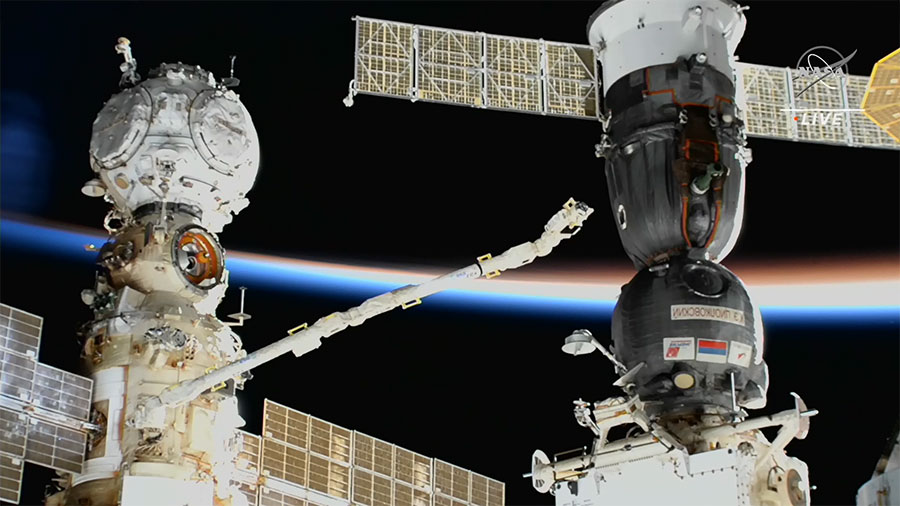
Things got dicey yesterday aboard the International Space Station (ISS). Late in the day, Russian cosmonauts Sergey Prokopyev and Dmitry Petelin were preparing for a spacewalk when exterior cameras showed a stream of white flakes pouring from the Soyuz spacecraft attached to the station. Simultaneously, telemetry indicated a drop in pressure in the Soyuz’s coolant tank, indicating that it was the source of the leak. Ground controllers ordered Prokopyev and Petelin, who were already suited up and preparing to exit the station, to scrub the spacewalk and stay indoors until the problem could be sorted out.
The development is a troubling one that could spell peril for the crew. The Soyuz that sprung the leak lifted off from the Baikonur Cosmodrome in Kazakhstan on Sept. 21, carrying Prokopyev, Petelin, and American astronaut Frank Rubio aloft. Spacecraft that bring crew members to the ISS remain docked to the station throughout the crew’s stay to serve both as their ride home and as a lifeboat in the event that an emergency requires them to evacuate on short notice. If the Soyuz is unsafe, the three crew members would have no immediate means of returning to Earth—and for now the outlook for the Soyuz is not good.
Rob Navias, NASA TV commentator, described the leak as “fairly significant,” adding, “No decisions have been made regarding the integrity of the Soyuz…or what the next course of action will be.” The cause of the leak, Navias said, is “unknown,” though pressure buildup within the coolant tank or even a hit from a piece of space debris could be to blame.
Prokopyev, Petelin, and Rubio are not the only crew members staffing the station. Also on board are NASA astronauts Nicole Mann and John Casada, Japanese astronaut Koichi Wakata, and Russian cosmonaut Anna Kikina. They arrived at the ISS aboard a SpaceX Crew Dragon spacecraft after their Oct. 5 launch. The Dragon remains docked to the station and is experiencing no problems, but on a return trip, it could accommodate only the four passengers it initially launched.
Just what the Russians will do if the Soyuz appears not to be flight worthy is unclear, but there is historical precedent for such a situation. In April 1979, a Soyuz spacecraft that was docked at the Soviet Salyut 6 space station developed a propulsion breakdown, and two months later, Russia launched an unpiloted replacement Soyuz that successfully docked and brought the crew home when their rotation was complete.
Roscosmos (the Russian space agency) could do something similar this time, jettisoning the current Soyuz and replacing it with a fresh one. But while Roscosmos would likely send the replacement much sooner than the two months it took in 1979, time would still be a critical factor. Everyday a faulty Soyuz remains docked to the station is a day that three of the crewmembers would not have a means to escape in the event of an emergency.
As of this writing, neither Russia nor the U.S. had a new status report on the state of the spacecraft. In an email to TIME this morning, NASA spokesman Joshua Finch wrote: “We are working toward providing a written update today, which we will post on the International Space Station blog: https://blogs.nasa.gov/spacestation/.”
More Must-Reads from TIME
- Cybersecurity Experts Are Sounding the Alarm on DOGE
- Meet the 2025 Women of the Year
- The Harsh Truth About Disability Inclusion
- Why Do More Young Adults Have Cancer?
- Colman Domingo Leads With Radical Love
- How to Get Better at Doing Things Alone
- Michelle Zauner Stares Down the Darkness
Write to Jeffrey Kluger at jeffrey.kluger@time.com